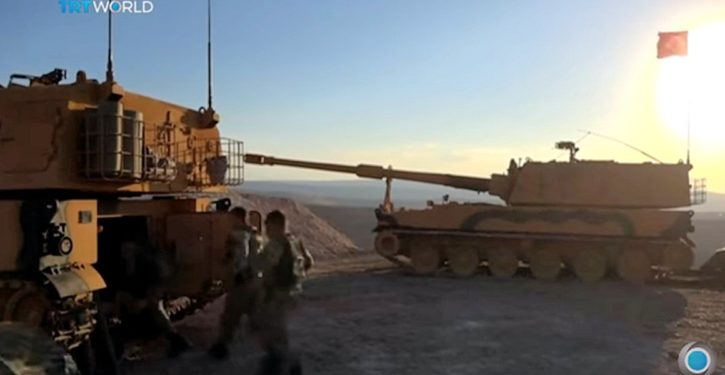
Western media are suggesting that a Turkish military initiative in northwestern Syria, which would have U.S.-backed Kurds as its target, would present an alliance problem for NATO. But that’s a misreading of the situation.
In fact, a popular Arab reading of the situation – that the Turkish move would put Ankara cross-ways with Russia – may also be a misreading. Russia and her client Bashar al-Assad don’t necessarily prefer the Kurds having control of the territory in question, as opposed to the Turkey-backed Free Syrian Army.
Ultimately, the Kurds are probably up a creek in this particular area. But to see why, we need to look at the map.
Will this presidential election be the most important in American history?
To begin with, Turkey’s urgency about making the move now, as opposed to months ago, arises officially from a newly announced U.S. plan to train and back a force of 30,000 Syrian Kurds in northeastern Syria, to act as a bulwark against a resurgence of ISIS in Syria’s eastern provinces, where the “Islamic State” had its core territory from late 2012 on.
Since early 2017, ISIS has been ejected from the key cities of Raqqa and Deir ez-Zor, and is now isolated to a pair of pockets in eastern Syria, seen in gray on the first map.

Most of the fighting to push ISIS out of the corridor from Raqqa to Deir-ez-Zor was done by the U.S.-backed Kurdish YPG. The YPG now controls the territory seen in yellow, between the Euphrates and Syria’s border with Turkey and Iraq. This area is where the 30,000-strong “border force” sponsored by the U.S. is to be established.
Turkey would object to such a plan under any form of leadership; it’s not just because the neo-Ottoman Islamist Erdogan is in power there that his government is opposed to the idea.
But that’s not really the story, because northeastern Syria is not where Turkey is now shelling YPG positions in preparation for a larger-scale incursion. The Turks’ objectives are way over to the west, in the YPG-controlled areas flanking the darker, pine-green territory occupied by Turkey’s Syrian client, the Free Syrian Army.

In other words, the “border force” plan in the east, however much Erdogan genuinely objects to it, is serving as the pretext for attacks further west. Turkey has been clear that the immediate objectives are YPG holdings in the towns of Afrin, west of the FSA area, and Manbij, to the east of it.
Manbij, in particular, is an enclave that had to be recovered from ISIS by the YPG. Prior to that operation, the YPG reportedly agreed to then turn it over to the Assad regime – but has since reneged on that deal, to the chagrin of Turkey.

If you look at the map, you can see why Turkey is chagrined. The Manbij enclave makes a shallow peninsula into the FSA’s territory, which would enable a Kurdish force to hold at continuing risk the FSA’s control of the west bank of the Euphrates. The Kurdish YPG holds the east bank of the great river; from Turkey’s perspective, the YPG cannot be allowed to remain in a privileged position on the west side as well. Turkey would prefer to push the Kurds back from Manbij and establish an FSA front with no flanking or penetration in that sensitive area.
To the west, meanwhile, the mountain-pass city of Afrin is the key to the mountainous Afrin District of Aleppo Province, which is endowed by nature to dominate the Turkish river valley that runs to the sea west of it, across the border.

It can’t fail to be of interest that this very geography figured in landmark historical events like the inbound march of Xenophon’s 10,000 toward Cunaxa in 401 B.C. (the outbound march to the Black Sea was what we know as the Anabasis), and Alexander the Great’s Battle of Issus with Darius III of Persia in 333 B.C., among others. More recently (and much alive in Turkish memory), the ancient city of Antioch, located close to modern Antakya, was besieged and occupied by European forces during the First Crusade, being dubbed the Kingdom (or Principality) of Antioch between A.D. 1098 and 1268.
The confluence of three rivers (the Karusu, the Afrin, and the Asi, or Orontes), running through coastal mountain ranges at the maritime border of this ancient land, still holds much of the geographic and strategic significance it has had for 2,500 years.

Turkey will not let it fall under unfriendly domination without a fight. The Kurds want to retain a commanding position relative to it; in large part – besides having an ethnic history in the local mountains – because occupying the position is a form of leverage.
Turkey has been able to live for decades with Syrian administration of this mountain redoubt. But a change of hands cannot be viewed from Ankara with complacency. There will be no “Thalatta! Thalatta!” from Kurdish fighters eying the Mediterranean to the west, if Turkey has anything to say about it.
It is partly because Turkey has a legitimate national-security stake in what happens in northwestern Syria that both Russia and the U.S. are inclined to accommodate some Turkish latitude there. But that’s not the only factor.
U.S. posture
On the U.S. side, comments from U.S. officials this week have been categorical and definitive. They also comport with what the U.S. is actually doing, and appear to serve as a reliable guide to what we can expect from the Trump administration going forward. From the Wall Street Journal article (top link):
Afrin and Manbij aren’t in the area where the U.S. plans the border force, and the U.S. military said Tuesday that it isn’t backing the YPG in Afrin. “That [area] is not part of our defeat-ISIS mission,” a U.S. military official said, suggesting that Washington isn’t inclined to forcefully counter Turkish attacks on the Kurds there. …
The State Department, asked about Turkey’s anger over the border force, said U.S. activities in Syria are aimed at preventing the return of Islamic State control.
“Turkey is a very important and valued NATO ally,” spokeswoman Heather Nauert said Tuesday. “We have a lot of interactions with the Turkish government.”
“The United States is in Syria to defeat ISIS,” she added. “That is solely what it is for.”
As I have noted before, Trump’s posture appears to be oriented on the limited charter of the war-on-terror Authorization for the Use of Military Force (AUMF). Destroying ISIS falls within that charter. Taking out stakes in the long-term disposition of Syria can be conveniently defined as outside of it, at least for now.
(Long-time readers know I can’t be content with Iran gaining a corridor through Syria to the Mediterranean, a process I have been tracking for nearly four years now. But the Trump administration’s policy is what it is. As with Obama’s, there is no use going high and right over it every whipstitch. I would point out, moreover, that a “border force” of 30,000 on the east side of the Euphrates would at least be in a position to hold Iran’s land bridge at risk, if not actually interdict it outright on command. The sustainability of such a force, and the U.S. investment in it, will still eventually require a favorable settlement for Syria as a whole. Remaining outside that dynamic continues to appear unrealistic, unless we are fine with the Iranian land bridge. And all that said, it’s largely moot if the Iranians can effect regime-change for themselves.)
This Trump administration approach is a reversion, as also observed a few weeks ago, to an earlier, pre-World War I style of American foreign policy.
Russian priorities
Russia, meanwhile, has a different set of concerns. In terms of reconsolidating defensible, unifiable territory for Assad, it’s better for Russia and her client to keep the Kurds in the north from bridging the Euphrates and getting within “Thalatta!” range of the Mediterranean. But all in all, letting Turkey take the heat for backing the Kurds into a corner in northwestern Syria is not the worst option.
It’s advantageous for Moscow to not have to attack the Kurds with Russian forces to accomplish that goal. The Kurds are the wedge into the seam between Turkey, Iran, and Iraq, and it’s better for Russia, which covets such a wedge for multiple reasons, to avoid unnecessary bad blood with them.
Turkish military actions could also create exploitable opportunities in the north for Russia and Assad – opportunities to do end-runs around Turkey and the FSA as well as see inconvenient Kurdish positions taken out. And if Turkey is operating where Russia controls the air space, Russia can influence the conditions of combat to shape such opportunities.
Of course, everyone involved will ritually decry the situation, calling for cessation of hostilities and so forth. But there’s a reason Turkey has been advising NATO of this operation for some time now, and NATO shows no signs of going to general quarters over it. It’s not going to break up the alliance.
Reporters doing drive-bys seem focused on the division-among-allies aspect of the situation. But the Trump administration isn’t overly concerned, and to all appearances, Moscow, London, Paris, and Berlin aren’t either. Our senses aren’t accustomed to it, but in some key ways, we are back to the world of 100 years ago, when it was not unthinkable, even within alliances, for great powers and their local clients to be doing what they felt they had to do, even when it didn’t fit idealistic narratives about international relations.
America, instead of being a sheriff or arbiter-in-chief, is just one of the great powers today – if still the most powerful one. The difference between before and after 20 January 2017 is one of pretense, not reality. In reality, we’ve been one of the great powers for the last seven years, having fully shed the post-1945 superpower role at the outset of the Arab Spring. We’re just not pretending otherwise anymore.




